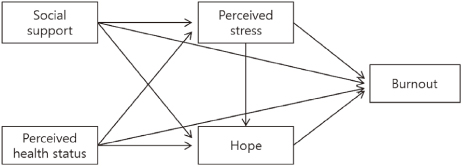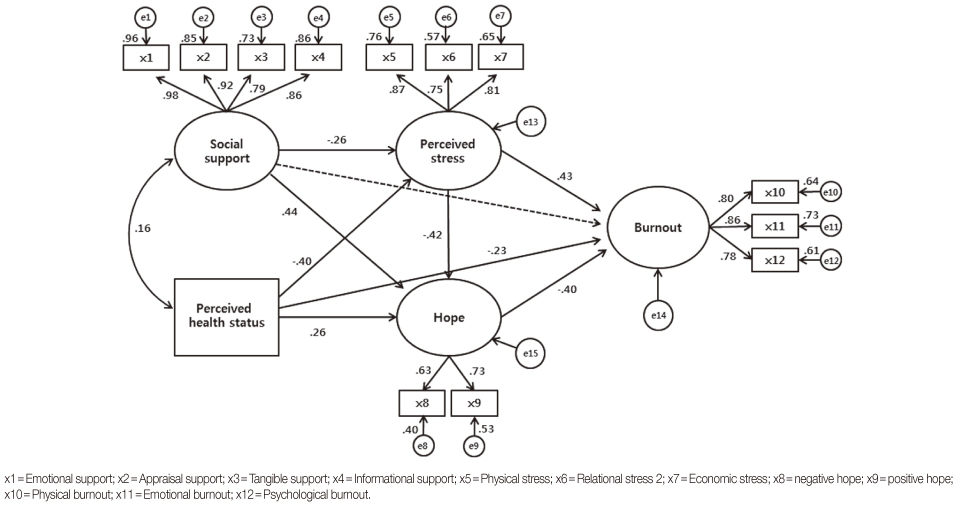Articles
- Page Path
- HOME > J Korean Acad Nurs > Volume 43(6); 2013 > Article
-
Original Article
- Structural Relationship of Burnout and Related Variables among Family Caregivers of Cancer Patients
- Min Joo Hong, Young Sook Tae
-
Journal of Korean Academy of Nursing 2013;43(6):812-820.
DOI: https://doi.org/10.4040/jkan.2013.43.6.812
Published online: December 31, 2013
1Department of Nursing, Changshin University, Changwon, Korea.
2College of Nursing, Kosin University, Busan, Korea.
- Address reprint requests to: Hong, Min Joo. Department of Nursing, Changshin University, 262 Paryong-ro, Masanhoewon-gu, Changwon 630-764, Korea. Tel: +82-10-2319-0190, Fax: +82-55-250-3170, mj1225@hanmail.net
© 2013 Korean Society of Nursing Science
Abstract
-
Purpose
- The purpose of this study was to construct a structural equational model to explain and predict burnout in family caregivers of patients with cancer. The study was based on the Stress-Appraisal-Coping Model of Lazarus and Folkman (1984) and Family Stress Theory (Hill, 1958).
-
Methods
- Data were collected from July 10 to September 30, 2012 through direct interviews and a self-report questionnaire survey. Participants in this study were 206 family caregivers providing care for patients with cancer in In-patient or Out-patient departments of three different general hospitals located in Busan. Measured variables were exogenous variables (social support and perceived health status) and endogenous variables (perceived stress, hope and burnout).
-
Results
- Goodness of fit in the hypothetical model was χ2=174.07, TLI=.95, CFI=.97, RMSEA=.08. Perceived health status, perceived stress, and hope showed statistically significant direct effects on burnout of family caregivers. Social support affected burnout of family caregivers indirectly. These variables explained 68.5% of total variance in burnout.
-
Conclusion
- The results from this study suggest that perceived stress, perceived health status, and hope should be considered as major influential factors when developing nursing interventions to control burnout of family caregivers (of patients with cancer).
This manuscript is based on a part of the first author's doctoral dissertation from Kosin University.
- 1. Ahn EJ, Lee YS. Burnout and burden of family care-givers for caring of terminal patients with cancer. J Korean Oncol Nurs. 2005;5(1):40–51.
- 2. Benzein EG, Berg AC. The level of and relation between hope, hopelessness and fatigue in patients and family members in palliative care. Palliat Med. 2005;19(3):234–240.ArticlePubMedPDF
- 3. Choi YS. Suffering experience of the family with cancer patients: Applied parse's human becoming research methodology. Daejeon, Konyang University. 2011;Unpublished master's thesis.
- 4. Duggleby W, Bally J, Cooper D, Doell H, Thomas R. Engaging hope: The experiences of male spouses of women with breast cancer. Oncol Nurs Forum. 2012;39(4):400–406. http://dx.doi.org/10.1188/12.onf.400-406ArticlePubMed
- 5. Feldman DB, Snyder CR. Hope and the meaningful life: Theoretical and empirical associations between goal-directed thinkingand life meaning. J Soc Clin Psychol. 2005;24(3):401–421. http://dx.doi.org/10.1521/jscp.24.3.401.65616Article
- 6. Given BA, Northouse L. Who cares for family caregivers of patients with cancer? Clin J Oncol Nurs. 2011;15(5):451–452. http://dx.doi.org/10.1188/11.cjon.451-452ArticlePubMed
- 7. Herth K. Development and refinement of an instrument to measure hope. Sch Inq Nurs Pract. 1991;5(1):39–51.PubMed
- 8. Hill R. Generic features of families under stress. Soc Casework. 1958;39:139–150.
- 9. Honea NJ, Brintnall R, Given B, Sherwood P, Colao DB, Somers SC, et al. Putting evidence into practice: Nursing assessment and interventions to reduce family caregiver strain and burden. Clin J Oncol Nurs. 2008;12(3):507–516. http://dx.doi.org/10.1188/08.cjon.507-516ArticlePubMed
- 10. Hong MJ, Tae YS, Noh MY. Relationships between stress, ways of coping and burnout of family caregivers of cancer patients. Asian Oncol Nurs. 2012;12(1):92–99. http://dx.doi.org/10.5388/aon.2012.12.1.92ArticlePDF
- 11. Kang KA, Kim SJ. Content analysis of difficulties in families with terminal cancer patients. J Korean Acad Community Health Nurs. 2005;16(3):270–281.
- 12. Keefe FJ, Ahles TA, Porter LS, Sutton LM, McBride CM, Pope MS, et al. The self-efficacy of family caregivers for helping cancer patients manage pain at end-of-life. Pain. 2003;103(1-2):157–162.ArticlePubMed
- 13. Kim MG, Park HS, Hong HS. Perceived family support in patients with chronic liver disease and burnout in primary family caregivers. Glob Health Nurs. 2012;2(1):8–17.
- 14. Kim YL, Yoo MS. A study on the relationship between the burden and the social support of family caregivers of breast cancer patients. Korean J Fam Welf. 2008;13(2):5–24.
- 15. Lazarus RS, Folkman S. Stress, appraisal, and coping. New York, NY: Springer Publishing Company; 1984.
- 16. McDaniel KR, Allen DG. Working and care-giving: The impact on caregiver stress, family-work conflict, and burnout. J Life Care Plann. 2012;10(4):21–32.
- 17. Ministry of Health & Welfare. Korea Central Cancer Registry. National Cancer Center. Annual report of cancer statistics in Korea in 2010. Seoul: Ministry of Health & Welfare; 2012.
- 18. Moon SB. Basic concepts and applications of structural equation modeling: With AMOS 17.0. Seoul: Hakjisa; 2009.
- 19. Northouse LL. Helping patients and their family caregivers cope with cancer. Oncol Nurs Forum. 2012;39(5):500–506. http://dx.doi.org/10.1188/12.onf.500-506ArticlePubMed
- 20. Ong AD, Edwards L, Bergeman CS. Hope as a source of resilience in later adulthood. Pers Individ Dif. 2006;41(7):1263–1273. http://dx.doi.org/10.1016/j.paid.2006.03.028Article
- 21. Park JW. A study to development a scale of social support. Seoul, Yonsei University. 1985;Unpublished doctoral dissertation.
- 22. Pines AM, Aronson E, Kafry D. Burnout: From tedium to personal growth. New York, NY: Free Press; 1981.
- 23. Rhee YS. A study of effect on quality of life of cancer patient's caregiver: Focusing on the mediating effect of feeling of burden and growth. Korean J Soc Welf. 2009;61(2):325–348.Article
- 24. Shin GY. Adaptation model for family caregiver of cancer patient. J Korean Oncol Nurs. 2002;2(1):5–16.
- 25. Shin GY, Kim MJ. Factors influencing stress appraisal of cancer patients' primary caregivers. J Korean Acad Adult Nurs. 2002;14(1):125–134.
- 26. Song MS, Lee EO, Park YS, Hah YS, Shim YS, Yu SJ. The concept analysis of hope: Among cancer patients undergoing chemotherapy. J Korean Acad Nurs. 2000;30(5):1279–1291.ArticlePDF
- 27. Suh SH. A study of the meaning and the change of familism in Korea. J Korean Home Manage Assoc. 2003;21(4):93–101.
- 28. Sung MR, Kim KA, Lee DY. Factors influencing burnout in primary family caregivers of elders with dementia. J Korean Gerontol Nurs. 2012;14(3):200–208.
- 29. Swore Fletcher BA, Dodd MJ, Schumacher KL, Miaskowski C. Symptom experience of family caregivers of patients with cancer. Oncol Nurs Forum. 2008;35(2):E23–E44. http://dx.doi.org/10.1188/08.onf.e23-e44ArticlePubMed
- 30. Tae YS, Heitkemper M, Kim MY. A path analysis: A model of depression in Korean women with breast cancer-mediating effects of self-esteem and hope. Oncol Nurs Forum. 2012;39(1):E49–E57. http://dx.doi.org/10.1188/12.onf.e49-e57ArticlePubMed
- 31. Teschendorf B, Schwartz C, Ferrans CE, O'Mara A, Novotny P, Sloan J. Caregiver role stress: When families become providers. Cancer Control. 2007;14(2):183–189.ArticlePubMedPDF
- 32. van Oostrom I, Meijers-Heijboer H, Duivenvoorden HJ, Bröcker-Vriends AH, van Asperen CJ, Sijmons RH, et al. Family system characteristics and psychological adjustment to cancer susceptibility genetic testing: A prospective study. Clin Genet. 2007;71(1):35–42. http://dx.doi.org/10.1111/j.1399-0004.2007.00731.xArticlePubMed
- 33. Yang KH, Song MR, Kim EK. The stress and adaptation in family caregiver of chemotherapy patients. Seoul J Nurs. 1998;12(1):118–132.
REFERENCES
Figure & Data
REFERENCES
Citations

- Effect of Laughter Therapy on Mood Disturbances, Pain, and Burnout in Terminally Ill Cancer Patients and Family Caregivers
Hee Moon, Songjah Journ, Seonah Lee
Cancer Nursing.2024; 47(1): 3. CrossRef - Structural Equation Model for Psychosocial Adjustment of Breast Cancer Survivors Based on Family Resilience Model
Jiyoung Seo, Myungsun Yi
Korean Journal of Adult Nursing.2022; 34(2): 178. CrossRef - The Mediating Effect of Depression on the Relationship between Social Support, Spirituality and Burnout in Family Members of Patients with Cancer
Won-Hee Jun, Kyung-Sook Cha, Kee-Lyong Lee
International Journal of Environmental Research and Public Health.2021; 18(4): 1727. CrossRef - Factors Influencing Depression of the Cancer Patient’s Family Caregivers
Min-joo Hong, Young-suk Kim, Bu-kyeong Bang, Ick-Jee Kim
The Korean Journal of Health Service Management.2019; 13(3): 163. CrossRef - Factors Influencing Burnout in Primary Family Caregivers of Hospital-based Home Care Patients
Ju Ok Yang, Hye Kyung Lee
Journal of Korean Academy of Community Health Nursing.2018; 29(1): 54. CrossRef - Factors Affecting Caregivers' Burnout Caring for a Family Member in an Intensive Care Unit
Min-Jeong Park, So-Hee Park, Mi Young Chung
Korean Journal of Adult Nursing.2017; 29(5): 517. CrossRef - Factors Influencing Burden among Family Caregivers of Elderly Cancer Patients
Yooun Sook Choi, Joo Hee Bae, Nam Hee Kim, Young Sook Tae
Asian Oncology Nursing.2016; 16(1): 20. CrossRef - Relation of Compassionate Competence to Burnout, Job Stress, Turnover Intention, Job Satisfaction and Organizational Commitment for Oncology Nurses in Korea
Sun-A Park, Seung-Hee Ahn
Asian Pacific Journal of Cancer Prevention.2015; 16(13): 5463. CrossRef


Figure 1
Figure 2
Descriptive Statistics of Variables (N=206)
PHS=Perceived health status.
Fitness Statistics for Hypothetical and Modified Model (N=206)
NPAR=the Number of parameters in the model; DF=Degree of freedom; CMIN=Chi-sqaure value; TLI=Turker-Lewis index; SRMR=Standardized root mean square residual; CFI=Comparative fit index; RMSEA=Root mean square error of approximation; LO=Low RMSEA; HI=High RMSEA.
Effects of Variables in the Modified Model (N=206)
CR=Critical ratio; SMC=Squared multiple correlations.
PHS=Perceived health status.
NPAR=the Number of parameters in the model; DF=Degree of freedom; CMIN=Chi-sqaure value; TLI=Turker-Lewis index; SRMR=Standardized root mean square residual; CFI=Comparative fit index; RMSEA=Root mean square error of approximation; LO=Low RMSEA; HI=High RMSEA.
CR=Critical ratio; SMC=Squared multiple correlations.
 KSNS
KSNS
 E-SUBMISSION
E-SUBMISSION





 Cite
Cite

